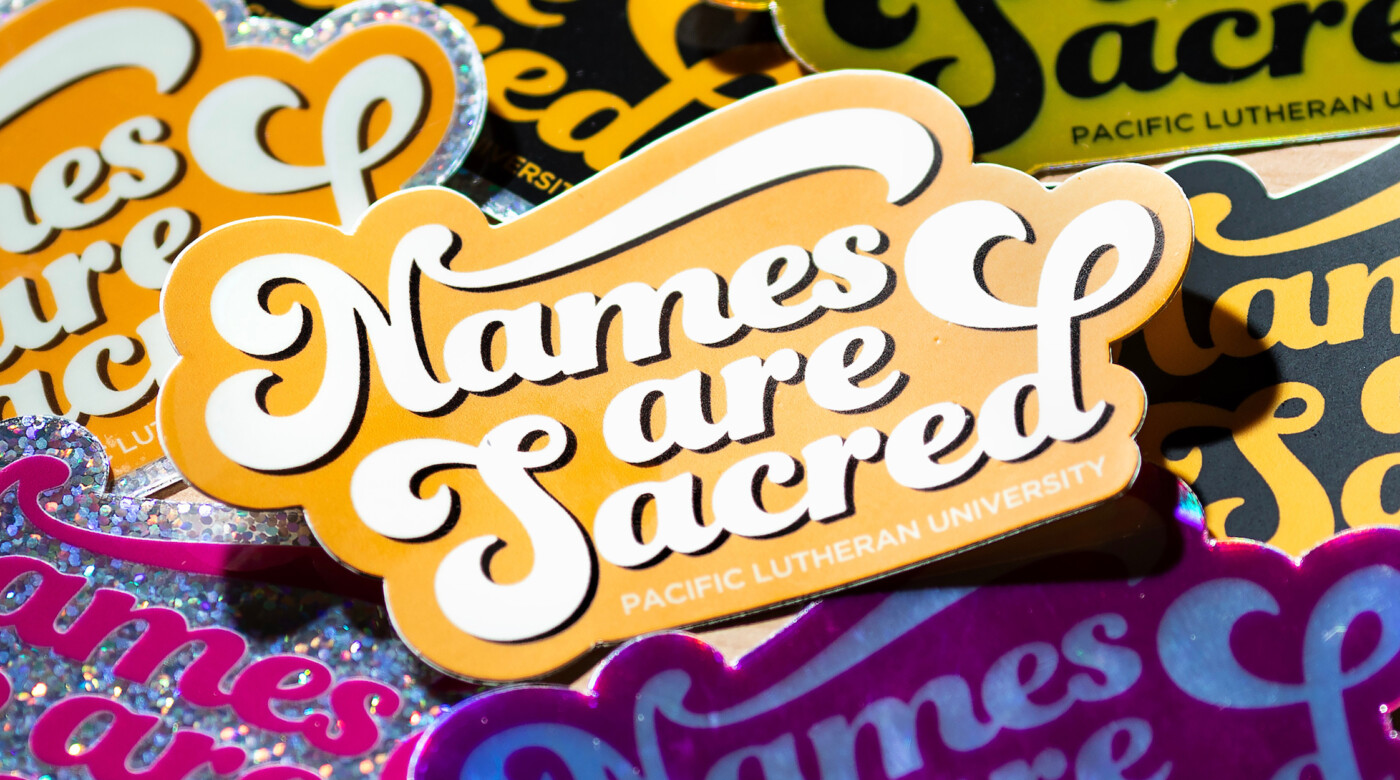What’s in a name? As it turns out, just about everything.

Image: Names Are Sacred stickers, a campaign by the Office of Diversity, Justice, and Sustainability and the Trans Task Force. The campaign aims to foster empathy and understanding around the importance of chosen names, promote an inclusive environment, and encourage community members to reflect on their own name journey. (PLU Photo / Sy Bean)
By Debbie Cafazzo
PLU Marketing and Communications Guest Writer
Every person’s name — given or chosen — is infused with meaning. Some names connect us to our ancestors or our families, while others represent a purposeful break from our past.
The PLU Names Are Sacred initiative promotes the concept of honoring someone’s name in the way that person wants — everything from learning the correct pronunciation of a name to respecting a name change or pronouns.
The campaign, now in its second year, grew out of collaboration between PLU’s Office of Diversity, Justice, and Sustainability, the campus Trans Task Force and others.
“We saw a need to make sure that we were being more proactive about the importance of names in the community,” says Angie Hambrick, Associate Vice President — Diversity, Justice and Sustainability.
“The great thing about Names Are Sacred is, at the core, it just tells us we need to slow down — and ask a question.”
Names Are Sacred offers classroom activities and advice on at the PLU Names Are Sacred website.
The goal is to foster empathy and promote an inclusive environment where everyone’s name is valued and acknowledged.
One activity asks students to write their name and a phonetic key for pronunciation on a card, and add their pronouns as an option. Another invites participants in a discussion group to share their name story, and reflect on how names contribute to their identities and sense of self. But always, those leading an activity are reminded that these discussions can be sensitive and emotional, and that not every participant will want to share.
The Names Are Sacred website also features interviews with students talking about their own names and the importance they attach to their names. Students point out that may be one name that your family uses, and another that you ask friends or people on campus to use.
“Having my name be part of my ethnicity — that means a lot to me,” explains Thalisa Saldivar ’25. “When it’s mispronounced and Americanized, it really hurts. Because that’s what I feel is my strongest tie to being Mexican.”
“I feel like most people don’t know how to say names in Arabic,” says Suhaib Ali ’26. “Within my culture, names are chosen with a certain level of care… Suhaib means compassion, kindness, gentleness. So I think that it is an extension of my identity and culture.”
Other students reflect on the importance of a professor respecting someone who decides to change their name — for example, midway through a semester.
“Be respectful, and just be knowledgeable,” advises Ja’Kenya Hoskins ’25. “This person is going through a change… it’s important to them. Do everything they can to give support to that student.”
New this year: a change in class rosters. Previously, the class roster listed a student’s legal name in the first column, and a preferred name in a second column. This year, if students enter their information into the campus system, the roster lists a student’s preferred name first, pronouns in a second column, then other information. The legal name is in the last column.
“It mitigated the harm we can do to students in a very simple way,” Hambrick says. “When you start off the semester by dead-naming or mispronouncing someone’s name, it can be hard to rebuild trust and rapport.”
Students with names that aren’t Euro-centric may encounter hesitation from people who are afraid they’ll make a mistake and mispronounce a name. It’s important to ask — and try to get it right.
But what happens if you don’t? Don’t panic, says Hambrick.
“We all make mistakes,” she says. “We should take the time to acknowledge and correct our mistakes.”



